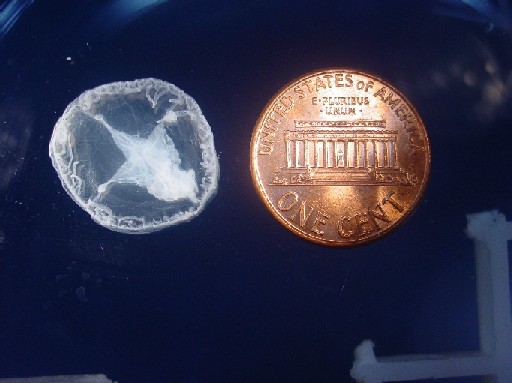Freshwater Jellyfish
Myriah Richerson - USGS © 

Common name: freshwater jellyfish
Synonyms and Other Names: peach blossom fish (China); Craspedacusta sowerbii (Lankester, 1880)
Identification: Craspedacusta sowerbyi is a hydrozoan (Phylum Cnidaria, Class Hydrozoa), which is most easily identified when it takes the form of a small, bell-shaped jellyfish, known as a hydromedusa. The hydromedusa measures about 5–25 mm in diameter, and is translucent with a whitish or greenish tinge (Peard, 2002; Pennak, 1989). It possesses five opaque-white canals, which form the gastrovascular cavity; four are radial and one is medially dorsoventral. Tentacles of varying lengths protrude from the upper margin of the velum, arranged with three to seven short tentacles between longer ones (Pennak, 1989; Slobodkin and Bossert, 1991). Freshwater jellyfish exhibit four very long tentacles, each parallel to a radial canal at the edge of the velum. Shorter tentacles facilitate feeding, while the longer ones give stability for swimming. The total number of tentacles varies from 50 to 500 (Pennak, 1989). Conspicuous swarms of hydromedusae appear sporadically, but are only one part of the animal's life cycle. Craspedacusta sowerbyi more often exist as microscopic podocysts (dormant "resting bodies"), frustules (larvae produced asexually by budding), planulae (larvae produced sexually by the hydromedusae), or as sessile polyps, which attach to stable surfaces and can form colonies consisting of two to four individuals and measuring 5 to 8 mm (Angradi, 1998; Acker and Muscat, 1976; Pennak, 1989; Peard, 2002).
Size: hydromedusa is 5–25 mm in diameter

